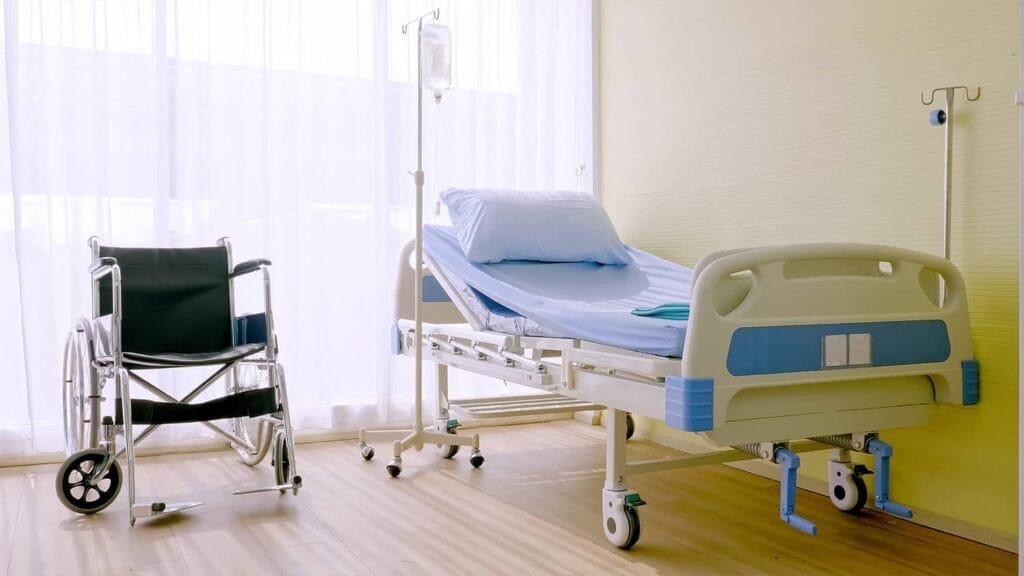Die Anschrift
304 Nordkardinal St.
Dorchester Center, MA 02124
Arbeitsstunden
Montag bis Freitag: 7:00 - 19:00
Wochenende: 10:00 - 17:00

Krankenhausbetten sind ein grundlegender Bestandteil der Patientenversorgung in Gesundheitseinrichtungen. Obwohl technologische Fortschritte zur Entwicklung hochentwickelter Betten mit zahlreichen Funktionen geführt haben, spielen einfache Krankenhausbetten weiterhin eine entscheidende Rolle. Diese schlichten, aber effektiven Betten sind für eine Vielzahl von Patienten und medizinischen Situationen unerlässlich. In diesem Artikel werden wir die Bedeutung einfacher Krankenhausbetten, ihre Funktionen und ihren Beitrag zu einer effizienten Gesundheitsversorgung näher beleuchten.
Ein einfaches Krankenhausbett, auch manuelles Krankenhausbett genannt, ist ein schlichtes Bett, das für den Einsatz im Gesundheitswesen konzipiert ist. Es verfügt typischerweise über Merkmale wie eine verstellbare Höhe für Kopf- und Fußteil sowie einen stabilen Rahmen.
Zu den wichtigsten Bestandteilen eines Standard-Krankenbetts gehören ein stabiler Rahmen, eine bequeme Matratze, Seitengitter zur Sicherung und ein Mechanismus zur Verstellung von Höhe und Neigungswinkel des Bettes.
Während einfache Krankenhausbetten nicht über die fortschrittlichen Funktionen ihrer elektrischen Pendants verfügen, können sie manuell so eingestellt werden, dass sie den Patienten eine bequeme Ruheposition ermöglichen.
Standard-Krankenhausbetten sind im Wesentlichen darauf ausgelegt, die grundlegenden Bedürfnisse von stationären Patienten zu erfüllen. Sie bieten eine stabile, verstellbare Liegefläche, die angehoben, abgesenkt und geneigt werden kann, um verschiedene Patientenpositionen und Pflegemaßnahmen zu ermöglichen. Standard-Krankenhausbetten umfassen typischerweise:

Einfache Krankenhausbetten sind günstiger als elektrische oder motorisierte Betten und stellen daher eine kostengünstige Lösung für Gesundheitseinrichtungen mit begrenztem Budget dar. Elektrische oder motorisierte Betten bieten zusätzliche Funktionen wie Höhenverstellung und verstellbare Rückenlehnen und eignen sich daher besser für Patienten, die häufig ihre Position wechseln müssen oder in ihrer Mobilität eingeschränkt sind. Für Einrichtungen, die eine grundlegende Versorgung gewährleisten möchten, ohne das Budget zu sprengen, sind einfache Krankenhausbetten jedoch eine praktische Wahl, die den Bedürfnissen vieler Patienten gerecht wird.
Ihre Einfachheit macht sie für ein breites Spektrum an Gesundheitsdienstleistern zugänglich, von großen Krankenhäusern bis hin zu kleinen Kliniken, und gewährleistet so, dass Patienten unabhängig vom Standort die angemessene Versorgung erhalten. Diese Vielseitigkeit ist der Schlüssel dazu, dass Gesundheitsdienstleistungen effizient und effektiv für alle Bedürftigen erbracht werden.
Da sie weniger bewegliche Teile haben, sind einfache Krankenhausbetten oft zuverlässiger und wartungsärmer als Betten mit komplexen elektronischen Systemen. Außerdem sind einfache Krankenhausbetten in der Regel kostengünstiger in der Anschaffung und im Betrieb, was sie zu einer praktischen Wahl für Gesundheitseinrichtungen macht, die ihr Budget optimal nutzen möchten.
Einfache Krankenhausbetten eignen sich gut für Patienten, die keine intensive Überwachung oder häufige Anpassungen benötigen, wie z. B. Patienten, die sich von kleineren Operationen erholen oder sich Routineuntersuchungen unterziehen.
In Notfallsituationen, in denen es zu Stromausfällen kommen kann, bleiben die grundlegenden Krankenhausbetten funktionsfähig, sodass eine ununterbrochene Patientenversorgung gewährleistet ist.
Um die Rolle von Standard-Krankenhausbetten besser zu verstehen, vergleichen wir sie hinsichtlich ihrer Eigenschaften und ihres Verwendungszwecks mit anderen Arten von Krankenhausbetten.
| Ausstattung/Betttyp | Einfaches Krankenhausbett | Halbelektrisches Krankenhausbett | Vollelektrisches Krankenhausbett |
|---|---|---|---|
| Kosten | Niedrig | Mäßig | Hoch |
| Verstellbarkeit | Handbuch | Elektrisch für Schlüsselfunktionen | Vollelektrisch |
| Wartung | Niedrig | Mäßig | Hoch |
| Machtabhängigkeit | Keiner | Manche | Hoch |
| Eignung | Nicht-kritische Pflege | Allgemeine Pflege | Intensivstation |
Einfache Krankenhausbetten sind ein unverzichtbarer Bestandteil des Gesundheitssystems und bieten eine kostengünstige und zuverlässige Lösung für die Patientenversorgung. Auch wenn sie nicht über die fortschrittlichen Funktionen modernerer Modelle verfügen, eignen sie sich für ein breites Spektrum an Patienten und medizinischen Situationen. Indem medizinisches Fachpersonal die Bedeutung dieser Betten und ihre Rolle im Gesundheitswesen versteht, kann es sicherstellen, dass Patienten die benötigte Versorgung erhalten.
Was unterscheidet einfache Krankenhausbetten von modernen Modellen?
Standardmäßige Krankenhausbetten bieten in der Regel grundlegende Funktionen wie Höhenverstellung, Seitengitter und manuelle Bedienelemente, während fortgeschrittene Modelle zusätzliche Funktionen wie elektronische Bedienelemente, integrierte Waagen und Patientenüberwachungssysteme beinhalten können.
Sind einfache Krankenhausbetten auch für die häusliche Pflege geeignet?
Ja, einfache Krankenhausbetten werden aufgrund ihrer Einfachheit, Zuverlässigkeit und Erschwinglichkeit häufig auch in der häuslichen Pflege eingesetzt. Sie bieten wichtige Unterstützung und Komfort für Personen, die längere Zeit bettlägerig sind oder sich zu Hause erholen müssen.
Können Standard-Krankenhausbetten auch Patienten mit besonderen medizinischen Bedürfnissen aufnehmen?
Ja, Standard-Krankenhausbetten lassen sich an die Bedürfnisse von Patienten mit unterschiedlichen Erkrankungen und eingeschränkter Mobilität anpassen. Zubehör wie Spezialmatratzen, Haltegriffe und Betttische können den Komfort und die Zugänglichkeit für Patienten mit besonderen Anforderungen verbessern.
Welchen Beitrag leisten einfache Krankenhausbetten zur Infektionskontrolle in Gesundheitseinrichtungen?
Standardmäßige Krankenhausbetten sind mit Materialien und Ausstattungsmerkmalen versehen, die die Reinigung und Desinfektion erleichtern und so dazu beitragen, die Ausbreitung von Infektionen im Gesundheitswesen einzudämmen. Glatte Oberflächen, abnehmbare Komponenten und antimikrobielle Beschichtungen gehören zu den Merkmalen, die die Infektionskontrolle unterstützen.
Welche Kriterien sind bei der Auswahl von Standard-Krankenhausbetten für Gesundheitseinrichtungen zu berücksichtigen?
Bei der Auswahl von Standard-Krankenhausbetten für Gesundheitseinrichtungen sind Faktoren wie Patientenkomfort, Sicherheitsmerkmale, Wartungsfreundlichkeit, Langlebigkeit, Kompatibilität mit vorhandener Ausstattung und die Einhaltung gesetzlicher Vorschriften zu berücksichtigen. Die Bewertung dieser Faktoren gewährleistet, dass die ausgewählten Betten den spezifischen Bedürfnissen und Anforderungen der Einrichtung und ihrer Patienten entsprechen.
